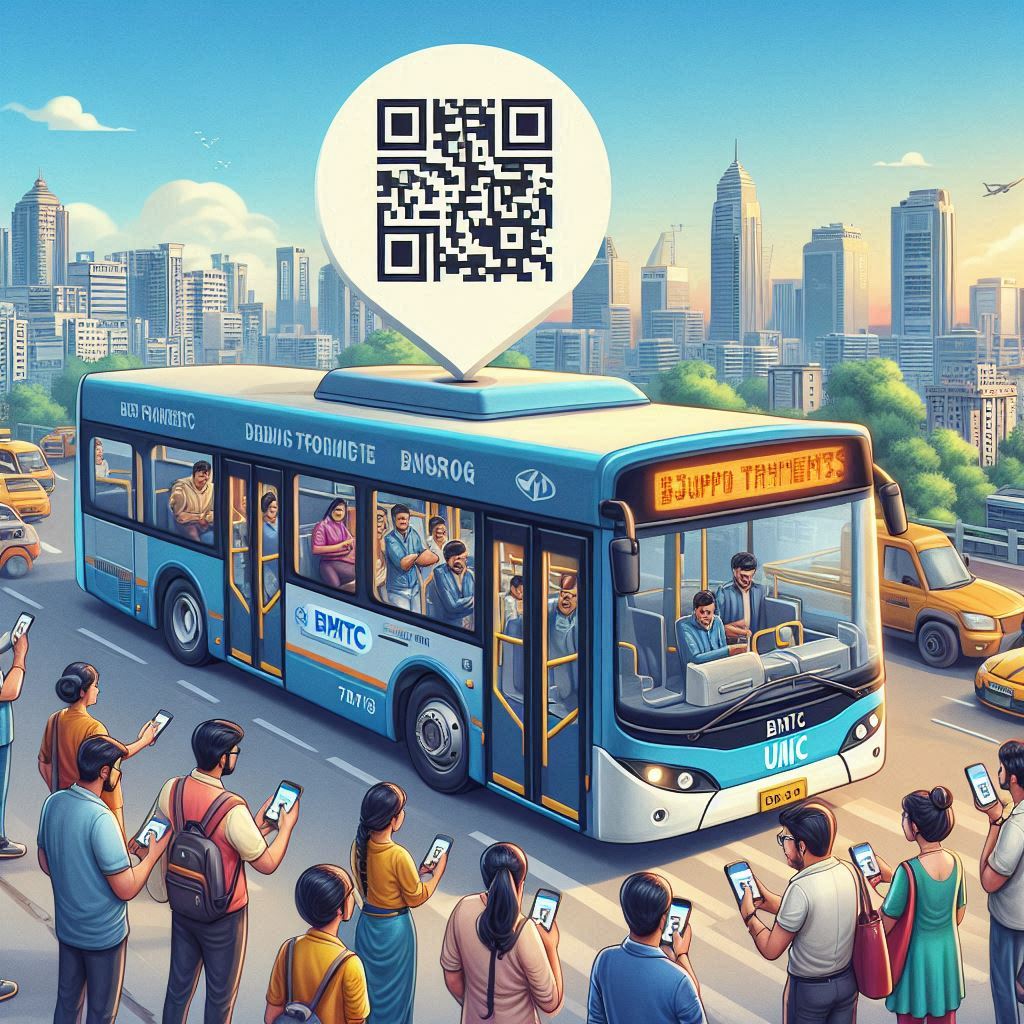The Bangalore Metropolitan Transport Corporation (BMTC) is making a transformative move towards a more modern, efficient, and cashless public transport system. In an effort to reduce the challenges of handling loose change and promote a seamless travel experience, BMTC has introduced QR codes on all buses to encourage UPI-based online payments. This bold step aligns with the corporation’s ambitious goal of boosting its daily revenue to ₹1 crore while also streamlining its operations for both passengers and staff.
The Rise of QR Codes: A Gateway to Cashless Transactions
As part of its initiative to move towards a digital-first approach, BMTC has installed QR codes across its entire fleet. This allows passengers to pay for their tickets conveniently through UPI-based apps, eliminating the need for physical cash and speeding up the payment process. The push for online payments comes at a time when traditional cash transactions have become increasingly inefficient, especially with the rising fares and the persistent issue of managing loose change.
While BMTC had been offering QR code payments for some months, the adoption rate was initially low. The corporation faced challenges, including a lack of enthusiasm among passengers and inconsistent use by conductors. However, with the recent fare hikes and the pressing need to resolve cash handling issues, BMTC is ramping up efforts to make QR code-based payments a norm on all buses.
Meeting the Revenue Target: ₹1 Crore Daily
BMTC’s primary aim with this cashless push is to significantly increase revenue through digital transactions. The corporation has set a target of generating ₹1 crore in daily revenue from UPI-based ticket payments. Currently, BMTC sees around ₹60 lakh in daily revenue from online payments, out of the ₹4 crore collected through over 40 lakh daily commuters. By encouraging passengers to use UPI apps, the corporation hopes to increase this share dramatically, ultimately hitting the ₹1 crore mark.
This digital transformation not only targets a higher revenue but also seeks to improve the operational efficiency of BMTC buses. With fewer cash transactions, conductors will no longer have to deal with the complexities of giving change, ensuring faster boarding times and a smoother overall experience for passengers. Furthermore, the reduction in physical cash transactions can help reduce the operational costs of managing currency and improve financial transparency within the system.
How QR Code Payments Work: Simplifying the Commute
Passengers can now scan the QR codes placed on buses and make instant payments through their preferred UPI apps like Google Pay, PhonePe, or Paytm. This method allows for faster and more secure transactions compared to cash payments. Furthermore, it offers the convenience of paying from the comfort of a mobile phone, eliminating the need to carry physical cash or coins.
In addition to the QR code implementation on buses, BMTC has integrated QR code generation into its existing electronic ticketing systems. This means that not only can passengers make payments directly via their smartphones, but conductors can also assist in generating and processing QR codes, making the whole transaction process more efficient.
Overcoming Challenges: Promoting Digital Payments
Despite the promising benefits of a cashless system, BMTC faced some early resistance to the adoption of QR code payments. One of the key challenges was inconsistent use by bus conductors, who were often reluctant to promote QR payments, potentially leading to confusion among passengers. Another challenge was a lack of awareness and digital literacy among some commuters who were more accustomed to using cash for fare payments.
To tackle these issues, BMTC is ramping up its efforts to promote QR code payments through targeted awareness campaigns. The corporation plans to focus on high-traffic routes, including those connecting major business districts, the airport corridor, and IT hubs, where tech-savvy passengers are more likely to adopt digital payment methods. Additionally, BMTC is providing training for bus conductors to ensure that they can effectively assist passengers in using the new payment system, creating a more consistent and user-friendly experience across the entire fleet.
BMTC is also working on integrating additional features into its ticketing system to streamline the payment process further. For instance, the corporation is exploring the possibility of allowing passengers to pay for multiple tickets in one go, making it easier for groups of people to travel together without worrying about individual transactions. This kind of flexibility is expected to improve passenger convenience and encourage more frequent use of the cashless payment option.
The Impact on Passengers and the City
The introduction of QR code payments is more than just a technical upgrade—it’s a game-changer for public transport in Bangalore. Regular commuters like Mohammed Saif have welcomed this change, noting that UPI payments simplify the fare process and reduce the hassle of carrying exact change. With Bengaluru’s growing tech-savvy population, digital payment solutions are becoming the preferred choice, and BMTC is tapping into this trend to improve both passenger experience and revenue collection.
UPI adoption on BMTC buses also promotes financial inclusion. It opens up an accessible payment option for passengers who might not have access to traditional banking methods, allowing them to make secure payments and enjoy the benefits of digital transactions. This is particularly important in a city like Bangalore, where many commuters come from diverse socio-economic backgrounds.
For passengers who may be unfamiliar with digital payments, BMTC has been proactive in providing guidance through posters, announcements, and conductor assistance. Additionally, the corporation has ensured that UPI apps and QR codes are available in multiple languages to cater to Bangalore’s diverse population.
Promoting UPI Payments on Key Routes
To accelerate the adoption of digital payments, BMTC plans to intensify promotions on high-traffic routes such as the airport corridor and areas with heavy IT industry presence. These routes are likely to attract tech-savvy commuters who are already familiar with UPI-based transactions and can help drive the success of the initiative.
BMTC is also exploring collaborations with mobile wallet providers and fintech companies to offer passengers discounts, loyalty points, or cashbacks when using UPI payments on buses. These incentives will not only encourage passengers to adopt digital payments but also help establish long-term habits of cashless transactions.
Looking Ahead: A Cashless Future for BMTC
The transition to a cashless public transport system is a crucial step towards the modernization of BMTC’s services. As the corporation continues to push for digital payments, the efficiency of the entire system will improve, from faster boarding to reduced administrative costs. With more passengers adopting UPI payments, BMTC will be better equipped to handle the challenges of a growing city, making public transport more accessible, efficient, and future-ready.
Moreover, the data generated through cashless transactions will provide BMTC with valuable insights into passenger preferences, travel patterns, and peak times. This data can be used to optimize routes, adjust bus schedules, and offer personalized services, ultimately enhancing the overall travel experience. It could also pave the way for the introduction of dynamic pricing models based on demand, allowing BMTC to maximize revenue during peak times.
The future of public transport in Bangalore is undeniably digital, and BMTC’s push for a cashless system is leading the way. As more passengers embrace QR code-based payments, the corporation is laying the groundwork for a smarter, more connected public transport infrastructure that caters to the needs of a modern, tech-driven city.
In conclusion, BMTC’s decision to install QR codes across its fleet is a positive and forward-thinking move. By encouraging digital payments, the corporation is not only working towards its revenue target of ₹1 crore a day but also improving the overall commuting experience for millions of Bangaloreans. This cashless approach is set to redefine the future of public transport in the city, offering a smarter, faster, and more inclusive solution for all commuters.
Key Takeaways:
- BMTC has introduced QR codes on all buses to encourage UPI-based digital payments.
- The goal is to generate ₹1 crore in daily revenue through increased adoption of online payments.
- QR code payments offer a faster, more secure, and efficient alternative to cash transactions.
- BMTC plans to promote UPI payments on high-traffic routes to boost adoption.
- The shift to cashless payments will improve operational efficiency and contribute to a more modern and inclusive transport system in Bengaluru.
- Data from digital transactions can help BMTC optimize services and improve the passenger experience further.
Reference: bangaloremirror

 Ultimate Travel Guide to Yana, Gokarna, and Surrounding Places
Ultimate Travel Guide to Yana, Gokarna, and Surrounding Places